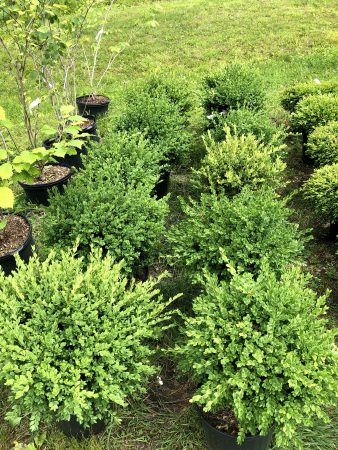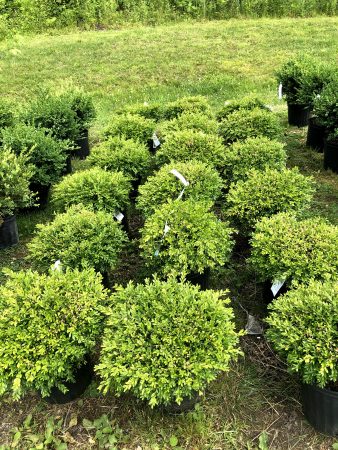The Boxwood Species, (Buxus Sempervirens) happens to be one of the most popular shrub types in most landscape projects today. With almost 200 varieties of Boxwood out there, it is an evergreen shrub that is native in many different regions. A good majority of the Boxwood family grows slow and short and is often used for borders or edging around houses and in landscape designs, while some others grow extremely tall and are great for entrance ways or shade. Boxwoods produce thick coats of evergreen leaves and thrive best in moist, well drained, and slightly acidic Soil.
WHAT KALLECO NURSERY USUALLY HAS IN STOCK:
GREEN MOUNTAIN BOXWOOD can grow to be about 5 feet tall and is often used for hedges and borders as it can be pruned to a variety of shapes. This boxwood is easy to care for, it just needs watering about once a week.
GREEN VELVET BOXWOOD grows to be about 3-4 feet wide and tall, so it grows in more of a round shape, than linier. This variety needs full to partial sun and holds up in extreme cold conditions.
FRANKLINS GEM BOXWOOD is great because it can withstand both shade and sun so you can plant it almost anywhere in your garden. Another favored aspect of Franklins Gem is that as it grows it tends to keep its round shape without needing much pruning.
GEM BOXWOOD is also low maintenance, being deer and drought resistant, it stays small and green all winter long.
SOME OTHER BOXWOOD VARIETIES:
ENGLISH BOXWOOD is often referred to as the dwarf boxwood as it grows slowly and often stays small, at its tallest reaching only about 3 feet. Its roots grow shallow, so it is important to protect it against too much heat and mulching around the base of the tree is helpful as well.
AMERICAN BOXWOOD grows a darker and shinier colored leave and is one of the easiest varieties to maintain as it is pretty much pest and disease resistant. The most common American Boxwood grows to be about 10 feet tall, but some are known to grow as tall as 20 feet, because of this it is often used as a natural barrier or wall in landscape. The American Boxwood can withstand extreme conditions from cold temperatures and harsh winds to droughts, making it a good match for many different regions. Under the American Boxwood are several different varieties, here are a few:
DEE RUNK BOXWOOD grows in more of an upright and narrow position and produces more broad shaped leaves.
FASTIGIATA BOXWOOD produces smaller oval and glossy leaves that tend to stay dark green all year round. One great upside to this variety is that it is not a deer favorite, so they do tend to stay away from it.
VARDAR VALLEY BOXWOOD has the tendency to grow as tall as a large tree and it produces smaller oval shaped leaves. For this variety it is suggested to prune in early spring.
JAPANESE BOXWOOD grows at a slower rate like the English Boxwood does and even produces flowers in the spring that bees love. It is important to fertilize this boxwood three times a year, the spring, summer and in the fall. Some common varieties of Japanese boxwood are:
GREEN BEAUTY BOXWOOD keeps its dark colored leaves throughout the hot summer months and is drought tolerant. This boxwood tends to grow between 4-6 feet tall and is often used to accent entry ways and around foundation beds.
MORRIS MIDGET BOXWOOD needs partial to full sun to grow as well as regular watering. Similar to the English Boxwood, this is a dwarf boxwood and grows slow, with an average height of 12 inches and usually becomes up to 18 inches wide.
MORRIS DWARF BOXWOOD on the other hand can grow up to 2 feet tall and is also slow growing. This variant requires almost no maintenance but does need partial sun and moist soil.







